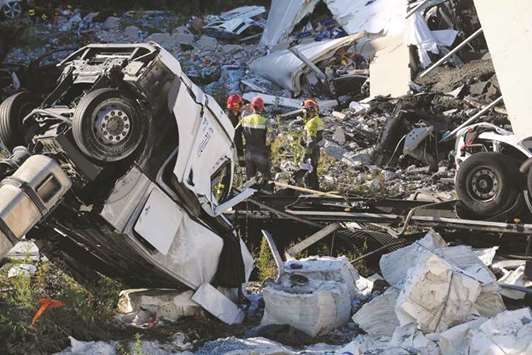Italy’s populist government yesterday intensified its attacks on the bridge operator it blames for the viaduct collapse that killed dozens of people in Genoa, as rescuers picked through rubble on the third day of desperate efforts to find survivors.
Anger is mounting over the tragedy and the structural problems that have dogged the decades-old Morandi bridge, which buckled without warning on Tuesday, sending about 35 cars and several trucks plunging 45m onto railway tracks below along with huge chunks of concrete.
The government has accused infrastructure giant Autostrade per L’Italia of failing to invest in sufficient maintenance — a claim the company denies — and said it would seek to revoke its lucrative contracts.
Interior Minister Matteo Salvini demanded that the company offer up to 500mn euros ($570mn) to help families and local government deal with the aftermath of the disaster.
“If we’ve put up 5mn euros, they should offer 500mn,” he told reporters. “There needs to be an immediate, concrete and tangible signal for these families: they should put their hands on their hearts and in their wallets.”
The collapse has prompted fears over other ageing infrastructure in Italy and abroad, with Bulgaria announcing a plan yesterday to renovate more than 200 bridges while France has said one in three of national road bridges are in need of repair.
With Genoa’s chief prosecutor saying that between 10 and 20 people could still be missing under the huge piles of concrete, rescue workers clambered across the rubble hoping to find survivors.
Fire official Emanuele Gissi said the unstable mountains of debris made the search operation dangerous.
“We are still looking for cavities that can hide people, living or not,” he said, adding that the round the clock search had failed to find any more victims overnight.
Cranes and bulldozers worked to help clear the site as rescuers try to cut up and remove the biggest slabs of concrete.
At least 38 people were killed, according to an update yesterday by Prime Minister Giuseppe Conte.
The dead include children aged eight, 12 and 13, according to Salvini, while three Chileans and four French nationals are among those killed. Sixteen people were injured.
High above the frantic rescue effort, the engine of a green truck perched at the edge of the remaining strand of bridge continues to whir, a symbol of the heart-stopping moment when the bridge buckled during a storm, tossing vehicles into the abyss.
Its driver saw the ground in front of him collapse and managed to slam on the brakes just inches from disaster.
He did not cut the engine as he fled the crumbling structure and his employer has said the truck has enough fuel to run for several more days, wipers and lights still on.
Other incredible stories of survival have emerged.
Marina Guagliata and her 24-year-old daughter were in a shop under the bridge when huge chunks of concrete smashed through the building.
“I was buried up to my chest, and my daughter was completely buried,” said Guagliata, 58, who appeared on Italian television with her head bandaged.
Her daughter Camilla remains in hospital with a crushed leg and fractures to her pelvis, ribs and an arm, as well as a punctured lung.
Genoa’s Morandi viaduct was completed in 1967 and has been riddled with structural problems for decades, leading to expensive maintenance and severe criticism from engineering experts.
Its collapse prompted the government to announce a year-long state of emergency in the region and day of mourning tomorrow.
Autostrade, which estimates it will take five months to rebuild the bridge, denies scrimping on motorway maintenance, saying it has invested over 1bn euros a year in “safety, maintenance and strengthening of the network” since 2012.
With pressure mounting, it released a statement yesterday saying ambulances would be able to travel on its roads toll-free from now on to “further enable the precious rescue and aid operations”.
With little hope of returning home soon, many are staying with relatives, while local hotels and individuals have offered free lodging to those displaced.

Rescuers inspect the rubble and wreckage yesterday by the Morandi motorway bridge after a section collapsed in Genoa on Tuesday.


